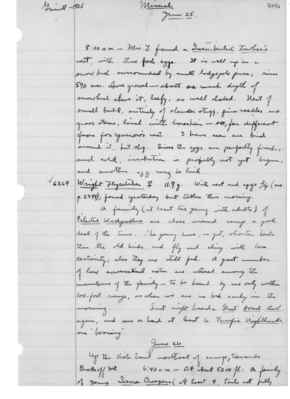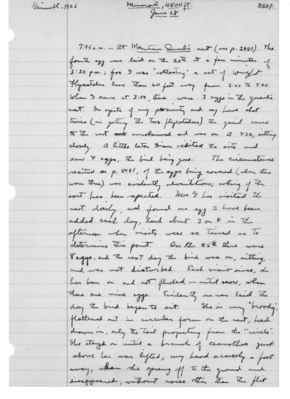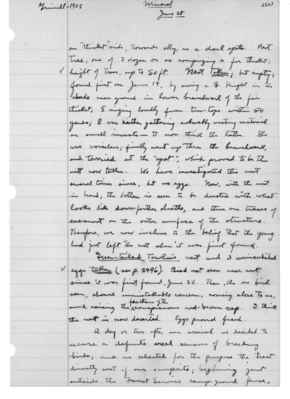Pages That Mention 1925-06-25
1925: Joseph Grinnell's field notes
S2 Page 42
Collector: Grinnell - 1925 Location: Mineral Date: June 25 Page Number: 2496
8:00 a.m. - Mrs. G. found a Green-tailed Towhee's nest, with three fresh eggs. It is well up in a snow bush surrounded by small lodgepole pines; rim 590 mm. above ground - about as much depth of snowbush above it, leafy, so well shaded. Nest of small bulk, entirely of slender stuff, pine needles and grass stems, lined with horsehair - so, far different from fox sparrow's nest. I have seen one bird around it, but shy. Since the eggs are perfectly fresh, and cold, incubation is probably not yet begun, and another egg may be laid.
6264 Wright Flycatcher [female symbol] 11.9 g. With nest and eggs 3/4 (see p. 2494); found yesterday but taken this morning.
A family (at least two young with adults) of Pileated Woodpeckers are close around camp a good deal of the time. The young have, as yet, shorter tails than the old birds, and fly and cling with less certainty; also they are still fed. A great number of low conversational notes are uttered among the members of the family - to be heard by us only within 100-foot range, as when we are in bed early in the morning. Last night heard a Great Horned Owl again, and saw or heard at least 6 Pacific Nighthawks, one "booming".
June 26 Up the Vista Trail northeast of camp, towards Brokeoff Mt. 6:40 a.m. - At about 5200 ft.: A family of young Sierra Creepers (at least 4, tails not fully
S2 Page 47
Collector: Grinnell - 1925 Location: Mineral, 4800 ft. Date: June 28 Page Number: 2501
7:45 a.m. - At Mountain Quail's nest (see p. 2481). The fourth egg was laid on the 20th at a few minutes of 2:30 p.m.; for I was "collecting" a set of Wright Flycatchers less than 60 feet away from 3:00 to 3:40. When I came at 3:00, there were 3 eggs in the quail's nest. In spite of my proximity and and my have [sic] shot twice (in getting the two flycatchers) the quail came to the nest and unobserved and was on at 3:30, sitting closely. A little later Dixon visited the site and saw 4 eggs, the bird being gone. The circumstance recited on p. 2481, of the eggs being covered (when there were three) was evidently adventitious; nothing of the sort has been repeated. Mrs. G has visited the nest daily, and found one egg to have been added each day, laid about 3 or 4 in the afternoon when visits were so timed as to determine this point. On the 25th there were 8 eggs, and the next day the bird was on, sitting, and was not disturbed. Each visit since, she has been on and not flushed - until now, when there are nine eggs. Evidently one was laid the day the bird began to sit. She is very "broody", flattened out in circular form on the nest, head drawn in, only the tail projecting from the "circle". She stayed on until a branch of ceanothus just above her was lifted, my hand scarcely a foot away, when she sprang off to the ground and disappeared, with noise other than the flit
S2 Page 49
Collector: Grinnell - 1925 Location: Mineral Date: June 28 Page Number: 2503
on "thicket" side, towards sky, as a dark spot. Nest tree, one of 2 dozen or so comprising a fir thicket; height of trees, up to 50 ft. Nest taken; but empty; found first on June 14, by seeing a [female symbol] Kinglet inthe shade near ground in lower branchwork of the fir thicket; [male symbol] singing loudly from tree-tops within 50 yards; [female symbol] was either gathering cobwebby nesting material or small insects - I now think the latter. She was voiceless; finally went up thru the branchwork, and tarried at the "spot", which proved to be the nest now taken. We have investigated this nest several times since, but no eggs. Now, with the nest in hand, the bottom is seen to be dusted with what looks like down-feather sheaths, and there are traces of excrement on the outer surface of the structure. Therefore, we now incline to the belief that the young had just left the nest when it was first found.
Green-tailed Towhee's nest and 3 unincubated eggs taken (see p. 2496). Bird not seen near nest since it was first found, June 25. Then, the one bird seen, showed unmistakable concern, coming close to me, and raising the ^feathers of the conspicuous red-brown cap. I think the nest is now deserted. Eggs proved fresh.
A day or two after our arrival we decided to secure a definite areal census of breeding birds; and we selected for the purpose the tract directly west of our campsite; beginning just outside the Forest Service camp-ground fence,


